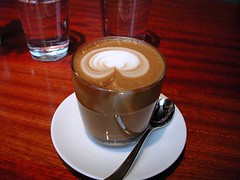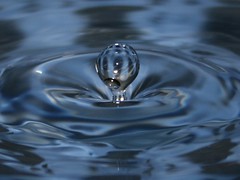While admittedly my research strength is on wastewater governance, I am well versed on the water scarcity literature. One of the concepts that has gained notoriety in the social science literature is the idea of virtual water. From the World Water Council’s website:
Darren recently wrote about Salt Spring Island Coffee and how much guilt they put into their coffee cup paper sleeves with the phrase “the cup of coffee you’re consuming travelled 20,000 miles to get to you” (I’m paraphrasing). In my comment to Darren, I indicated that this kind of guilt was nothing. I would like to share with you just how much water was consumed in producing that one cup of coffee you can’t give up: 140 litres, according to the latest calculation of the World Water Council. Yes, you heard right. 140 litres of water go into producing each cup of coffee.Virtual water is the amount of water that is embedded in food or other products needed for its production. For example, to produce one kilogram of wheat we need about 1,000 litres of water, i.e. the virtual water of this kilogram of wheat is 1,000 litres. For meat, we need about five to ten times more.[World Water Council]
People who are unaware of the negative environmental impact of excess water consumption argue that, after all, it’s *just* a cup of coffee and that we have enough water in the world. My question to them is – How much of the world’s water is available for human consumption? Yeah, I told you about that a few months ago, remember? 0.38% – not nearly enough to sustain our current consumptive patterns.
I’ll be the first to admit (disclosure time) that I do enjoy a cup of coffee, particularly when it comes to meetings with colleagues, friends, clients or the like. But I always feel guilty about it, and I try to find ways to diminish my water consumption, all the time. Moreover, a vast majority of my research work is on wastewater recycling and water conservation. Furthermore, I work hard at educating the public about the current state of the world in regards to water scarcity and the need to recycle and reuse wastewater.
The concept of virtual water isn’t new, but it is a powerful tool that helps us understand how negative our consumption patterns are. I just hope that the great work that water-focused researchers (myself included) are doing to highlight the negative consequences of our day-to-day activities and over-consumptive patterns can resonate with the public. Please remember that water is VERY, very scarce, before flushing your toilet, before purchasing bottled water, before taking long showers. Thank you.



Excellent post — and one that will make me think twice about making a pot of coffee this morning. But I’m curious to hear your point of view on what type of impact water conservation here in Vancouver has on water scarcity in other parts of the world. The coffee I drink comes from developing nations, and so directly impacts the amount of water available in those nations — but does taking a long shower really mean I’m making life harder for farmers in the southern hemisphere? Or does it just mean my neighbor has a bit less water with which to wash his car?
What I’m asking is — isn’t it possible to have a global water shortage without a local water shortage? And if so, how much do local actions in areas without shortages really help the global problem?
Excellent and very interesting article Dr. Pacheco.